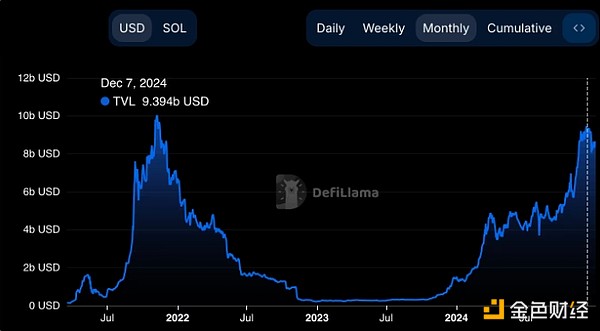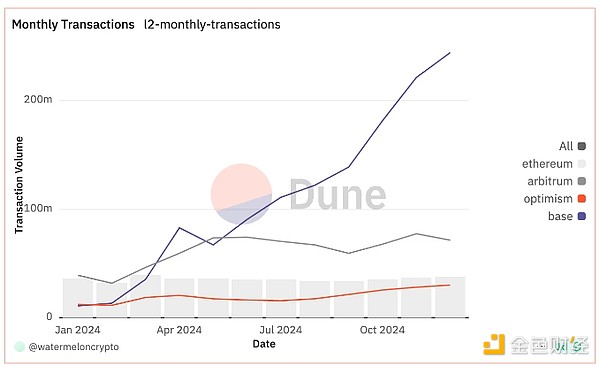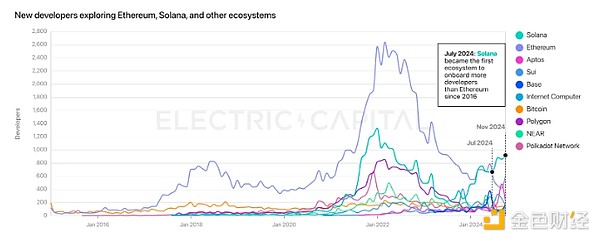Author: Benjamin Schiller, CoinDesk; Translator: Zhu Tao, Jinse Finance
This article reviews the breakthrough developments of 2024 and looks ahead to the potential trends in blockchain technology for the coming year.
Let's dive into the milestones, trends, and predictions shaping the next era of cryptocurrencies.
1. Review: Crypto Milestones of 2024
Ethereum's Duncun Upgrade: Ethereum saw its most significant network upgrade to date in 2024. Ethereum launched the Cancun-Deneb (Dencun) upgrade, a landmark improvement aimed at enhancing scalability and reducing data costs, marking a critical step in the network's evolution. Duncun introduced proto-danksharding, a mechanism designed to lower Layer 2 aggregation costs by simplifying data availability and increasing transaction throughput. While these changes sparked significant controversy, they aim to benefit developers and pave the way for further innovation in Ethereum's roadmap, solidifying its position as the leading smart contract platform.
Solana Locks in Value: Solana's DeFi TVL reached $9 billion in total locked value (TVL) for the first time in three years, as its DeFi ecosystem continues to experience further growth. This achievement reflects increased user engagement and the expansion of decentralized applications on the platform. Institutional adoption and major integrations have significantly driven this growth. Financial giants like Franklin Templeton and Société Générale have leveraged Solana for tokenized asset projects. Solana has also expanded its reach, with Robinhood adding SOL to its trading platform and Cboe Global Markets applying for an ETF linked to Solana, indicating increased confidence in its infrastructure.

The Quantum Computing Alarm: Google's advancements in quantum computing, particularly its revolutionary quantum chip, have sounded the alarm in the crypto community, highlighting the potential threats to blockchain security. The chip's ability to solve problems that traditional computers cannot has reignited debates about Bitcoin's reliance on traditional cryptographic methods and the broader implications for the crypto ecosystem. Experts emphasize the need to transition to quantum-resistant encryption to protect cryptocurrencies from future vulnerabilities. While current quantum computers are still unable to breach blockchain networks, Google's progress underscores the necessity of proactive measures to ensure the long-term security and resilience of digital assets.
Surge in Layer 2 Adoption: Layer 2 adoption has surged as projects like Arbitrum, Optimism, and Base play a crucial role in addressing Ethereum's scalability challenges. Arbitrum continues to dominate the Layer 2 ecosystem, with transaction volume exceeding 1 billion, driven by its strong developer support and DeFi integrations. Optimism has expanded its influence by leveraging its OP Stack technology, enabling modular Layer 2 solutions and fostering collaboration across the ecosystem through its Optimism Superchain integration. Base, a Coinbase-incubated Layer 2 project, has gained significant traction by leveraging Coinbase's extensive user base and on-ramps, with Franklin Templeton becoming the first asset manager to launch a tokenized fund on the network.

DeFi Leaders Innovate: Aave has become the focus of a new fund launched by Grayscale Investments in October, providing institutional and accredited investors with investment opportunities in its governance token (AAVE) through traditional investment vehicles; Uniswap Labs announced the launch of Unichain, a decentralized Layer-2 blockchain built on the Optimism OP Stack, aimed at improving transaction speed, reducing costs, and enhancing cross-chain interoperability, with plans to launch the mainnet in 2025; As part of its Endgame Plan, MakerDAO has rebranded to Sky, introducing a new governance (SKY) and stablecoin (USDS), autonomous "Sky Stars", deflationary token economics, and a roadmap to transition fully from MKR to the SKY token.
2. Emerging Trends for 2025
AI x Blockchain: The convergence of artificial intelligence and blockchain will fundamentally transform identity verification, predictive analytics, and smart contract automation — and may help mitigate the negative impacts of AI.
Regulated Crypto Hubs: Jurisdictions like Hong Kong, Dubai, and Singapore are positioning themselves as crypto-friendly innovation centers, attracting startups and institutional investors.
Interoperability Takes Center Stage: Cross-chain protocols will dominate development, enabling seamless asset transfer and collaboration across blockchain ecosystems.
3. Spotlight on 2024 Developers
The Electric Capital Developer Report highlights the continued growth in blockchain development, with a 35% increase in active developers. Ethereum, Solana, Polkadot, Base, and Polygon are leading the pack, showcasing their strong developer communities. Solana has been the biggest attractor of new developers, onboarding 7,625 in 2024, surpassing Ethereum. Solana's appeal stems from its low fees, fast transactions, and abundance of memecoins, making it a formidable competitor in the smart contract space.

4. Ones to Watch in 2025
Ethereum's Pectra Upgrade: Ethereum's upcoming Pectra upgrade, divided into the Prague and Electra phases, aims to ensure a smoother rollout of critical improvements to the consensus and execution layers. The Electra phase will enhance validator efficiency, strengthen network security, and introduce an improved validator exit management mechanism.
Scaling Solutions: ZK-rollups and modular blockchains will drive the next wave of scalability, ensuring a smoother user experience. Zero-knowledge proofs are emerging as a transformative technology that can enhance privacy and efficiency, while paving the way for blockchain networks to scale seamlessly without compromising decentralization.
Decentralized Identity: The rise of decentralized identity solutions may redefine how users interact with Web3 platforms, emphasizing privacy and ownership. These systems leverage blockchain technology to give users control over their personal data, enabling them to verify their identity without relying on centralized institutions.
5. Conclusion
The groundwork laid in 2024 sets the stage for the next chapter of cryptocurrencies, with breakthroughs in scalability, DeFi, and security shaping the transformative year ahead.







